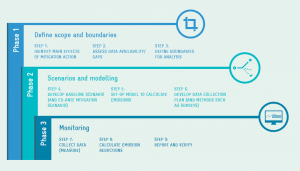
This content overview helps you navigate through the toolkit.
This toolkit on MRV is structured along three phases and nine steps proposed in GIZ’s Reference Document on Transparency in Transport (see figure below) and includes additional sections on capacity development and detailed case studies. To obtain a concise overview of the key principles for quantifying greenhouse gas emissions (GHG) in transport, it is useful to take a look at GIZ’s Beginners Guide to Emissions Accounting in Transport.

Figure 1: Three phases and nine steps for setting up an MRV system (Reference Document on Transparency)
In the first phase, practitioners need to identify the causal chain of mitigation actions.
Step 1: Identify main effects of mitigation action
First, the scope of the mitigation action as well as its effects are identified. Consequently, practitioners derive key indicators to track GHG emissions and effects on transport activities.
Step 2: Assess data availability/gaps
Then, practitioners check for institutionalised data (e.g. statistics), other available data sources (e.g. research, development aid projects) and determine the data to be collected.
Step 3: Define boundaries for analysis
Setting boundaries (spatial, temporal, sectoral, type of GHG emissions to be assessed) is a critical step for developing an MRV approach. Further, co-benefits for sustainable development are subsequently identified. The level of aggregation for reporting is defined (see Section 4.4 Reference Document on Transparency in Transport ) and the requirements for data collection are further elaborated on the basis of the defined boundaries.
In the second phase, scenarios are developed, models to calculate GHG emissions are identified and approaches to develop a data collection plan are elaborated.
Step 4: Develop baseline scenario and ex-ante mitigation scenario
The scenario and modelling phase always starts with the baseline that usually is based on historical data. The mitigation scenario then builds upon the baseline by varying key impact factors identified during mapping of the causal chain.
These documents provide examples of the different scenarios:
Step 5: Set-up model to calculate emissions
The Compendium on Greenhouse Gas Baselines and Monitoring: Passenger and Freight Volume is a comprehensive guide, which illustrates existing methodologies for GHG quantification of different types of transport mitigation actions.
The following tools are a selection of further useful methodologies:
Step 6: Develop data collection plan
Data needs identified before are distilled into a data collection plan; respective methods such as surveys are developed and documented. The data collected is used to validate and update the assumptions made in the scenarios. This gives insights into emission trends and shows the actual impact of the measures. For more specific details check section 2.2.3 in the Transport NAMA Handbook.
The following documents provide examples for potential sources of data for different emission quantification methods:
In the third phase, data are collected, emission reductions calculated and an MRV plan is developed.
Step 7: Collect data
Data collection comprises institutionalized data as well as data from surveys and observations. The quality of the data has to be controlled. In the case of dynamic baselines, an update of the baseline assumptions is undertaken in each reporting year. In order to ensure verification, data need to be managed and documented.
Step 8: Calculate emission reductions Ideally,
Ex-ante modelling during mitigation action development is consistent with the ex-post monitoring approach and uses synergies. In monitoring (ex-post), the “mitigation scenario” is replaced by calculating real emissions and comparing them to the baseline.
The tools introduced in step 5 can be applied throughout this step.
Step 9: Report and verify
For reporting, an MRV plan is necessary that can be updated with useful methodological improvements. Data and procedures need to be documented carefully to facilitate verification.
Emission reductions in transport may need to be reported to domestic stakeholders, the UNFCCC, e.g. under the Enhanced Transparency Framework of the Paris Agreement, as well as financial institutions and donors.
Verification of reported data is done through an independent process that assesses the completeness, consistency and reliability of the reported information.
This section includes series of webinars, tutorials and guidebooks for various methodologies and tools within the MRV process.
Webinars
Tutorials
Guidebooks
In addition to the case studies mentioned in the respective steps, this section contains a diverse collection of case studies compiled from specific mitigation measures from different regions.
You are currently viewing a placeholder content from X. To access the actual content, click the button below. Please note that doing so will share data with third-party providers.
More Information